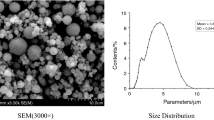Abstract
The paper reports results of studying the combustion of ultrafine aluminum (surface average diameter of particles is ≈ 0.1 μm) in a sealed bomb at an initial air pressure of 1 atm. The combustion proceeds in two stages, similarly to combustion in air. It is shown that during the two‐stage combustion of ultrafine aluminum powder in the bomb, the mass concentration of chemically bound nitrogen in the final products increases by ≈ 20% in terms of aluminum nitride. An increase in nitrogen content in confined combustion validates the previously proposed mechanism of binding air nitrogen with participation of the gas phase during aluminum combustion.
Similar content being viewed by others
REFERENCES
P. F. Pokhil, A. F. Belyaev, Yu. V. Frolov, V. S. Logachev, and A. I. Korotkov, Combustion of Powdered Metals in Reactive Media [in Russian], Nauka, Moscow (1972).
Yu. I. Petrov and R. Sh. Bibilashvili, "Release of gaseous products during oxidation of aluminum and transformations of its oxide shell," Zh. Fiz. Khim., 38, No. 11, 2614–2624 (1964).
E. L. Dreizin, "Experimental study of stages in aluminum particle combustion in air," Combust. Flame, 105, 541–556 (1996).
A. P. Il'in and L. T. Proskurovskaya, "Two-stage combustion of an ultradisperse aluminum powder in air," Fiz. Goreniya Vzryva, 26, No. 2, 71–72 (1990).
Takeshi Tsushida, Takeshi Hasegawa, and Michio Inagaki, "Self-combustion reaction induced by mechanical activation: formation of aluminum nitride from aluminum-graphite powder mixture," J. Amer. Ceram. Soc., 77, No. 12, 3227–3231 (1994).
G. V. Nikolaeva, H. T. Denisov, O. N. Efimov, and A. E. Shilov, "Reduction of molecular nitrogen by Ti (II) in a proton medium," Kinet. Katal., 34, No. 1, 186–187 (1993).
A. P. Il'in, G. V. Yablunovskii, and A. A. Gromov, "Influence of additives on the combustion of ultradisperse aluminum powder and chemical binding of air nitrogen," Fiz. Goreniya Vzryva, 32, No. 2, 108–110 (1996).
A. P. Ilyin, A. A. Gromov, and E. M. Popenko, "Role of palladium at superfine aluminum powder combustion in air," in: Proc. of the Third Russian-Korean Int. Symp. on Science and Technology (KORUS'99), Novosobirsk State Tech. Univ., Novosibirsk (1999), pp. 622–624.
V. P. Glushko, L. V. Gurvich, G. A. Hachkuruzov, et al. (eds.), Thermodynamic Properties of Individual Substances: Handbook [in Russian], Vol. 2, Izd. Akad. Nauk SSSR, Moscow (1962).
V. G. Shevchenko, V. I. Kononenko, I. V. Lukin, et al., "Effect of heating conditions of powdered lanthanum on its interaction with air," Fiz. Goreniya Vzryva, 35, No. 1, 85–88 (1999).
Author information
Authors and Affiliations
Rights and permissions
About this article
Cite this article
Il'in, A.P., Gromov, A.A., Vereshchagin, V.I. et al. Combustion of Ultrafine Aluminum in Air. Combustion, Explosion, and Shock Waves 37, 664–668 (2001). https://doi.org/10.1023/A:1012928130644
Issue Date:
DOI: https://doi.org/10.1023/A:1012928130644



